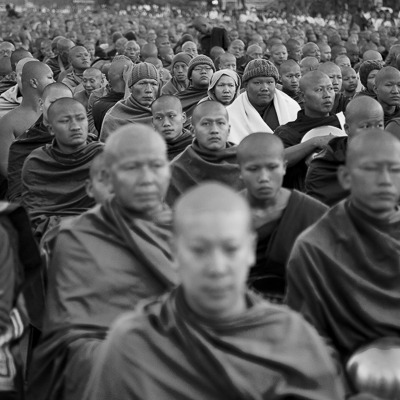Artistic use of Depth of Field
January 7th, 2020Now that we have a basic understanding of depth of field let’s talk briefly about how to use it to express your artistic vision.
I’ve written before (October 15, 2019) about focal contrast and how our eyes are drawn to areas in an image that are contrasty, sharp and in focus. We can use that to direct the viewer’s attention within the image.
In a portrait the area of highest importance is the subject’s eyes, which should be tack-sharp. Other areas of the image, especially the background, should be deemphasized so as to not distract from the subject. This can be accomplished by using a backdrop that is plain, in shadow or blurred. Blurring a background is trivial through the use of a large aperture (small f-number) and adequate distance between the background and the subject.
Another artistic use of a shallow depth of field is to isolate one object out of a field of repeating objects. In the following image, taken during a Buddhist alms-giving ceremony in Chiang Mai, Thailand, I used a shallow depth of field and tonal contrast to bring the viewer’s attention to rest on the monk who is looking at the camera in the upper-right. He acts as the focal point both literally and figuratively.

(Canon 5DMII, EF24-105 @ 105mm, 1/100s, f/4, ISO2500)
In this next image, of a group of villagers rescuing a fishing boat that sunk overnight in a storm, I used a large depth of field to help tell the full story; from the sizable anchor on the end of the rope at the right edge of the image up to the swamped boat on the left.

(Canon 5DMII, EF24-105 @ 24mm, 1/100s, f/11, ISO 400)
I could have made other artistic choices. For example I could have used a large depth of field to emphasis the sea of monks and let the one monk with a lighter colored shawl take a lesser, but still prominent, role in the image. The apertures that I chose serve to convey the mood and message that I felt and wished to share.
As an artist, depth of field is one of the useful tools that allow us to share our vision and interpretation of the world.
